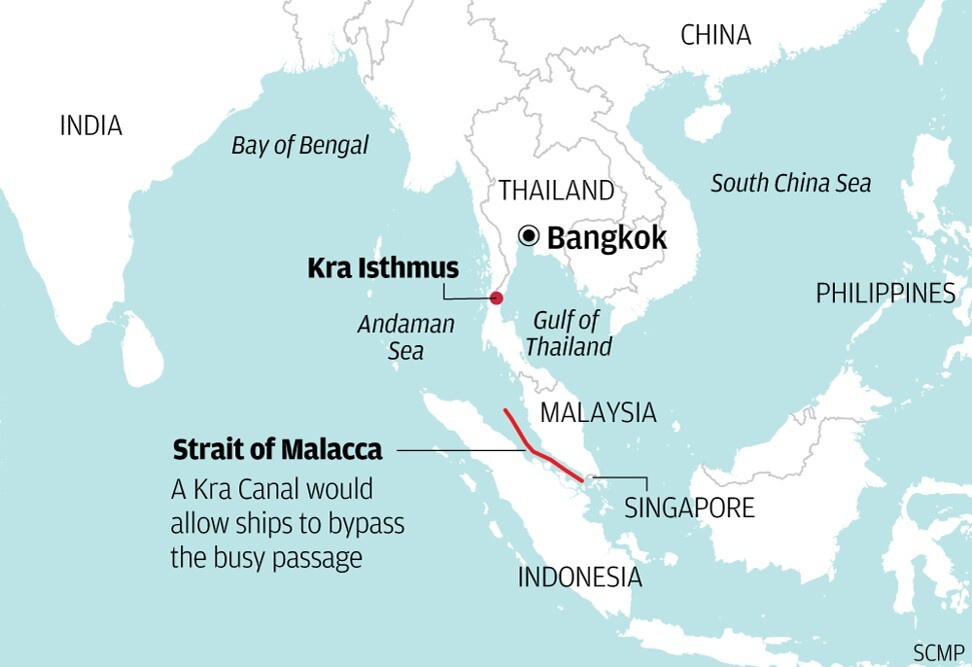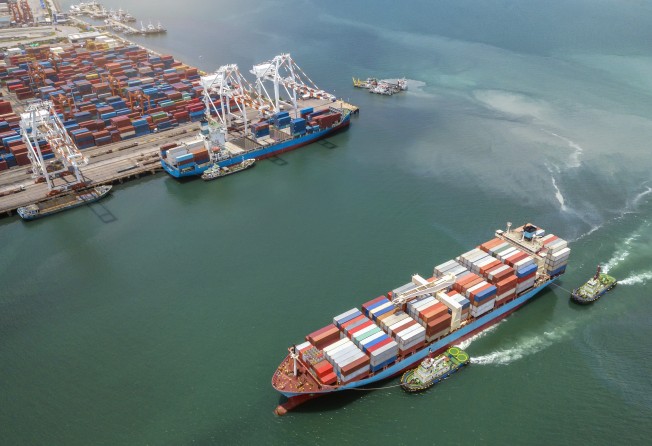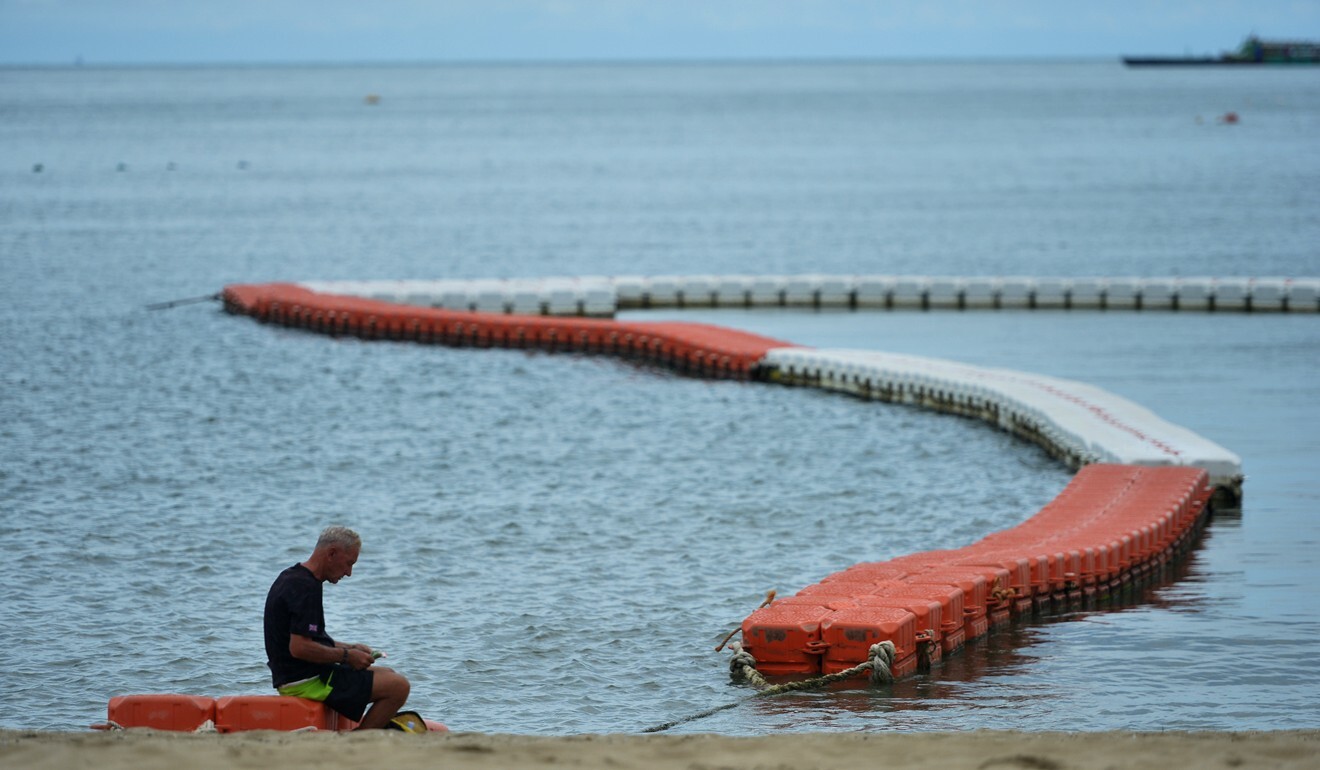
Will Thailand’s bid to bypass Strait of Malacca ever be built – and will China play a part?
- The idea of a Kra Canal linking the Indian and Pacific oceans dates back more than 300 years and, now, Bangkok is studying a ‘land bridge’ to replace it
- But amid US-China tensions and Thailand’s economic woes, analysts aren’t sure it’s a sound or necessary plan

Every few years, or every few governments, the idea of digging a canal across Thailand’s Kra Isthmus – creating a maritime passageway between the Andaman Sea and the Gulf of Thailand – is brought up, thrown around, and set aside.
The idea of a Kra Canal, which dates back more than 300 years, is aimed at maximising the potential of Thailand’s central location in Indochina by cutting through the narrowest part of the Malay Peninsula to allow the swifter movement of commerce – and, in the old days, troops.
Modern advocates of the project say it will shave about two days off the time it usually takes cargo ships to pass through the Strait of Malacca, one of the world’s busiest shipping lanes and currently the shortest sea route linking India and the Middle East with the Asia-Pacific region. The canal was put on the back burner after a Thai Senate committee advised against certain routes in 2004, but in recent weeks the plan to make Thailand a crucial international logistics outpost through the link has been raised once again – with a twist.
Instead of a canal, the country’s cabinet on Tuesday approved a 68 million baht (US$2.2 million) feasibility study to look into a rail and highway link that would potentially connect two deep water ports to be built on either side of the isthmus.
Transport Minister Saksiam Chidchob told Bloomberg last month the 100km land bridge would replace the canal project, which would cause too much destruction to the environment.
With Thailand struggling to recover from the economic impact of the Covid-19 pandemic, Prime Minister Prayuth Chan-ocha said the ports and land bridge would ensure Thailand’s economic stability in the long run, and gradually shift its tourism- and export-reliant economy to a more technologically driven one.
It is a grand plan, but the history of similar projects failing to materialise has made critics and businesses wary. Despite years of feasibility studies, observers say arguments for the canal or a land bridge are dogged by financial and management concerns, security and diplomatic issues, as well as uncertainty over Thailand’s geopolitical future in the face of the United States and China’s deepening rivalry in the region.
Sumeth Suwanphrom – a member of the Thai Canal Association for Study and Development, a civilian advocacy group for the project backed by several retired generals – said a parliamentary study earlier this year estimated the cost of digging a canal and constructing seaports on either side of the coast at 2 trillion baht. With an investment of that size, he expects “cooperation from many nations” to help Thailand manage the project.
Sumeth said interest in the project was revived by a retired general who saw that it would create jobs and bring in much-needed development for the marine agriculture and tourism-dependent economy of Thailand’s southern provinces, and also help quell the long-simmering insurgency in the region.
Critics, on the other hand, point out that a canal would effectively separate those provinces from the rest of the country, potentially adding fuel to the conflict.
Another factor is Beijing’s interest in and potential involvement with a Kra Canal, which has been the topic of much speculation over the years. The Thai Canal Association has long claimed any such project would have support from China, but those with a different point of view include Thammasat University associate professor of economics Aksornsri Phanishsarn, who said Beijing did not have to look to a canal for maritime connectivity in the region.

“China … has other logistics projects to connect to the Indian Ocean, such as the Kyaukpyu deep water port in [Myanmar’s] western Rakhine state,” she said, adding that a land bridge would be a more efficient mode of transport than the canal, and would be a logistical spine for Thailand’s two special economic zones, the Southern and Eastern Economic Corridors.
Ian Storey, senior fellow at the ISEAS-Yusof Ishak Institute, sees China’s expression of engagement in the Thai canal project as “opaque”.
“In the mid-2000s, Chinese strategic analysts suggested the canal would enhance the country’s energy security by reducing the need for Chinese-flagged oil tankers to transit through the Strait of Malacca, which was ‘controlled’ by the US,” he wrote in a 2019 paper.
“While this so-called Malacca Dilemma [coined in 2003 by China’s then president Hu Jintao] was always exaggerated, strategic analysts in China still view a Kra canal as a useful way to achieve ‘risk dispersal’.
“Beijing has never officially promoted the canal as a Belt and Road Initiative project. Nevertheless, in the view of many Thai analysts, Beijing is quietly pushing Chinese companies to support the canal.”
But to many in Thailand, in the light of the pandemic, China’s involvement is less of an issue than domestic economic concerns. Ghanyapad Tantipipatpong, chairman of the Thai National Shippers’ Council, said arguments over both the land bridge and the canal were lacking in many areas.
“The focus is on reducing the travelling time for cargo ships, [but] how long will it take for the cargo traffic to pass through? What about other facilities and infrastructure?” she said. “Creating seaports on both ends of the canal would mean damaging the reefs on both sides, and the environment and tourism will be affected.”

Ghanyapad said that given the current global trade downturn due to Covid-19 and the US-China trade conflict, many in the Thai export sector were not sure if the project would be able to pay for itself.
“There’s a 24-hour turnaround time in Busan port or Singapore port, while in [Thailand’s] eastern Laem Chabang port, it usually takes longer, so the Thai canal might not help reduce the time eventually [if there is a lack of efficiency or know-how in managing the port].”
Sumeth from the Thai Canal Association argued that the land bridge was not as practical, as it would involve containers having to be unloaded from ships at one end and back onto different vessels at the other end.
“The amount of time spent on that would discourage the diversion of routes from the Strait of Malacca,” he said. “The canal, on the other hand, would save that time.”
Storey from the ISEAS-Yusof Ishak Institute told This Week in Asia that while a land bridge would be significantly cheaper than a canal, “truth be told, neither are economically viable”.
“At a time when global demand for goods has slumped, and the price of oil has fallen through the floor, shipping companies don’t need to ‘shave off’ two days’ sailing time, which both the land bridge and canal would supposedly do. Container shipping companies make their money through scheduled reliability, not faster sailing times,” he said.
“In view of the Covid-19-induced global economic crisis, few investors would be willing to put money into projects that will generate only meagre returns at best. Moreover, at present the Prayuth government is preoccupied with trying to deal with calls for greater democracy and reform of the monarchy. It doesn’t have the political bandwidth to consider initiatives such as this.” ■